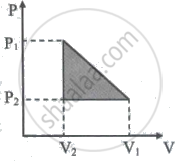Advertisements
Advertisements
Question
Suppose a person wants to increase the efficiency of the reversible heat engine that is operating between 100°C and 300°C. He had two ways to increase efficiency.
- By decreasing the cold reservoir temperature from 100°C to 50°C and keeping the hot reservoir temperature constant
- by increasing the temperature of the hot reservoir from 300°C to 350°C by keeping the cold reservoir temperature constant.
Which is the suitable method?
Solution
Heat engine operates at initial temperature = 100°C + 273 = 373 K
Final temperature = 300°C + 273 = 573 K
At melting point = 273 K
Efficiency η =
=
= 0.3491
η = 34.9%
(a) By decreasing the cold reservoir, efficiency
T1 = 300°C + 273 = 573 K
T2 = 50°C + 273 = 323 K
Efficiency η =
=
= 0.436
η = 43.6%
(b) By increasing the temperature of hot reservoir, efficiency
T1 = 350°C + 273 = 623 K
T2 = 100°C + 273 = 373 K
Efficiency η =
=
= 0.401
η = 40.1%
Method (a) More efficiency than method (b).
APPEARS IN
RELATED QUESTIONS
State Kelvin-Planck's statement of the second law of thermodynamics.
Why does heat flow from a hot object to a cold object?
Explain in detail the Carnot heat engine.
Derive the expression for Carnot engine efficiency.
A Carnot engine whose efficiency is 45% takes heat from a source maintained at a temperature of 327°C. To have an engine of efficiency of 60% what must be the intake temperature for the same exhaust (sink) temperature?
10 One mole of a van der Waals' gas obeying the equation

For a heat engine operating between temperatures t1 °C and t2 °C, its efficiency will be ______.
Heat engine transfers ______.
Which statement is incorrect?
The thermal efficiency of a heat engine is 25%. If in one cycle the heat absorbed from the hot reservoir is 50000 J, what is the heat rejected to the cold reservoir in one cycle?
